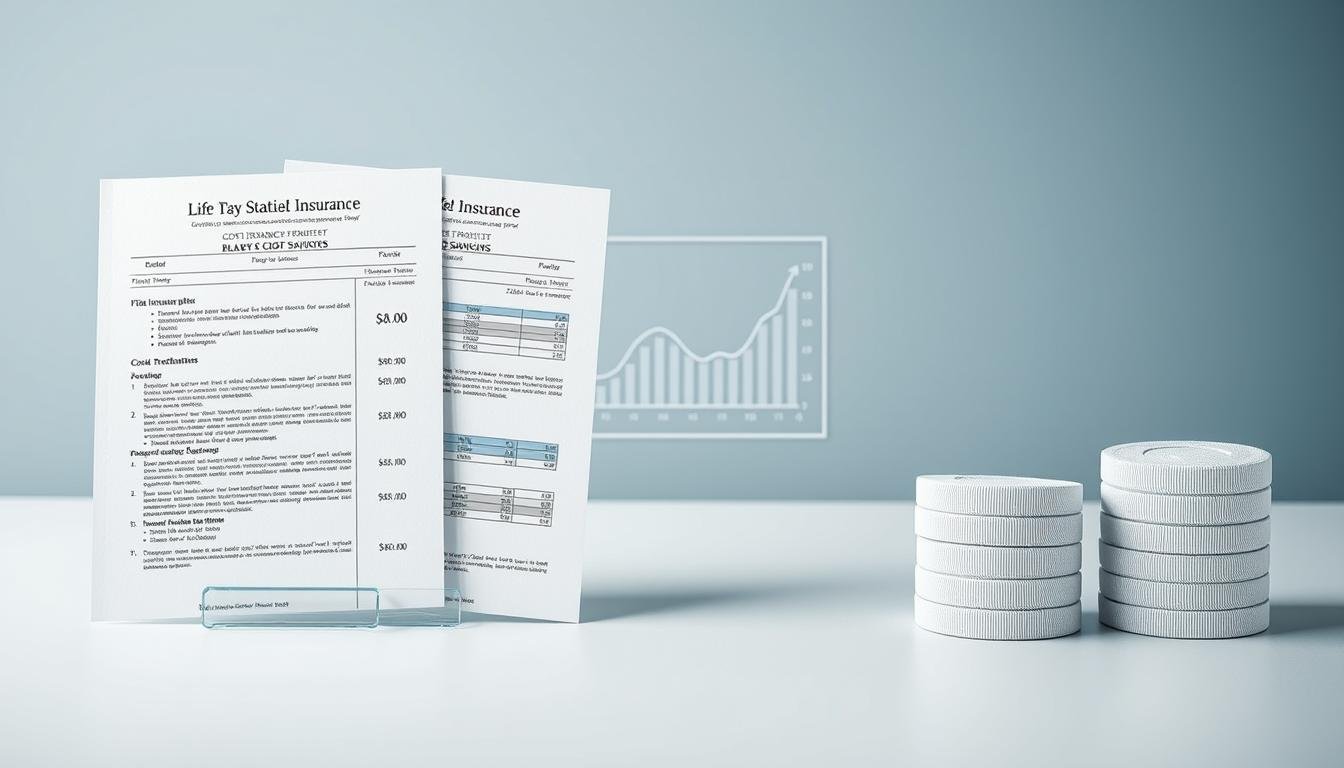Finding affordable life insurance can be tough1. It’s important to compare costs and look for ways to save. Knowing the basics and types of policies helps us make smart choices for our families.
We want the best value from our life insurance2. Exploring and comparing different options is key. This way, we can find affordable plans that offer the financial security we need.
Key Takeaways
- We should conduct a life insurance cost comparison to find the most affordable options.
- Understanding the basics of life insurance is key to making good choices.
- There are many life insurance plans, like term and whole life insurance.
- Exploring and comparing can help us save on life insurance.
- Affordable life insurance gives us the financial security we deserve.
- It’s vital to consider what affects life insurance costs when deciding.
Understanding the Basics of Life Insurance
Life insurance basics are key to knowing which policy fits our needs. It’s about protecting our loved ones financially if we pass away or become disabled. Sadly, 34 percent of U.S. adults have fallen victim to scams in the last year3. This shows how vital it is to have a solid financial plan, including life insurance.
There are many life insurance policies out there, like term and whole life insurance. Term life covers us for a set time, while whole life lasts forever. Knowing these differences helps us pick the right policy for our needs.
Also, 68 percent of Americans have faced a financial scam at some point3. This makes learning about life insurance even more important. By understanding the different policies, we can choose wisely and protect our families financially.
Factors That Affect Life Insurance Costs
Understanding the factors that affect life insurance costs is key. Life insurance cost factors vary based on several important elements. For example, a person’s age and health greatly influence their premiums. Older or less healthy individuals usually pay more4.
Choices also play a big role in life insurance costs. Activities that are high-risk or health issues can lead to higher premiums. The amount of coverage you choose also affects the cost, with more coverage meaning higher premiums5.
When picking a life insurance policy, it’s important to think about these factors. Knowing how life insurance cost factors relate to age and health factors and choices helps make better choices. This way, you can find a policy that fits your needs and budget6.
Term Life Insurance: An Overview
Term life insurance covers you for a set time, usually 10 to 30 years. It’s known for being affordable and flexible. This makes it a popular choice for many people. Let’s dive into what makes term life insurance special, including its benefits and who it’s best for.
Term life insurance has some big advantages. For example, it often costs less than whole life insurance. You can also switch it to whole life insurance later. People who need coverage for a certain time, like until their kids are grown or their mortgage is paid off, are good candidates.
When looking at term life insurance, think about your finances and how much coverage you need. You can use online tools or talk to an insurance agent to find the right policy. Consider your age, health, and lifestyle to get the most from your policy.

In summary, term life insurance is a good choice for those wanting affordable and flexible coverage. Knowing the benefits and who it’s best for can help you decide. According to data5, high-yield savings accounts can offer up to 4% interest. But, it’s important to weigh all the pros and cons before choosing.
Whole Life Insurance: Is It Worth It?
Whole life insurance covers you for life if you keep paying premiums. It also has a cash value part for financial planning. It’s key to know the good and bad sides and how it matches your financial plan.
Understanding Whole Life Insurance
Whole life insurance gives a guaranteed death benefit and grows in cash value. It’s a solid tool for whole life insurance financial planning. It can also help secure your family’s future and add to your retirement income.
Pros and Cons of Whole Life Insurance Policies
The benefits include a guaranteed death benefit, growing cash value, and tax perks. But, it has higher costs than term life and can be complex. Think these over before choosing whole life insurance.
About 25% of American families live on the edge financially7. This shows why it’s vital to weigh whole life insurance pros and cons in whole life insurance financial planning. This ensures you can afford premiums without financial trouble.
Financial Planning with Whole Life Insurance
Whole life insurance can be a key part of your financial plan. It offers a guaranteed death benefit and a cash value for extra income or emergencies. By looking at the pros and cons and how it fits your financial goals, you can decide if it’s right for you.
Assess your finances, including income, expenses, and savings, to see if whole life insurance suits your whole life insurance financial planning needs.
Comparing Premiums: Term vs. Whole Life
When looking at term life insurance vs whole life insurance, it’s key to check the premium costs. Whole life insurance can cost 5 to 15 times more than term life insurance8. For example, a 20-year term life policy for a healthy 30-year-old male might cost $25 to $30 a month8. On the other hand, whole life insurance can range from $300 to $1,000 or more monthly, based on coverage and the person’s age and health8.
The investment part of whole life insurance is also important. Its cash value grows at a guaranteed rate, usually 2% to 4% a year8. Term life insurance, which covers a set period like 10, 20, or 30 years, doesn’t build cash value. It’s vital to compare the premium costs and investment parts of both types of insurance.
Here’s a quick comparison:
- Term life insurance: lower premium costs, no investment component
- Whole life insurance: higher premium costs, investment component with guaranteed growth rate
In the end, choosing between term and whole life insurance depends on your personal situation and financial goals. Knowing the premium costs and investment parts of each helps us make a choice that fits our needs and budget8.
The Role of Riders in Life Insurance
Life insurance riders add extra benefits and protection to policies. They can be added to fit the policyholder’s needs. Common riders include accidental death benefits, critical illness coverage, and waiver of premium riders. But, remember, these additions can raise the premium9.
The cost of riders depends on the type and the policyholder’s situation. For example, someone with a pre-existing medical condition might pay more9. It’s important to compare the benefits of riders to their costs. This helps decide if they’re right for your needs9.

Understanding the different riders and their costs is key. This way, you can tailor your policy to fit your needs and budget. Whether it’s common riders or specialized ones, finding the right balance is essential9.
Choosing the Right Coverage Amount
Choosing the right life insurance coverage is key. We must think about our financial duties, income, and dependents. This helps us figure out how much coverage we need. According to10, we should look at our income, debts, and future costs to find the right amount.
Assessing our financial situation is a big part of this. We need to look at our income, expenses, debts, and assets. We should also think about our lifestyle and financial goals. For example, paying off a mortgage or funding our kids’ education. By considering these, we can find a coverage amount that protects our loved ones well. As11 points out, a good mix of investments can help guide us in this process.
It’s also vital to think about how much coverage we need for our financial planning. Too little coverage can leave our loved ones in a tough spot. Too much can mean paying too much in premiums. Finding the right balance is key. This way, we can make sure our coverage amount is enough without costing too much. Remember, our goal is to give our loved ones peace of mind and financial security.
In the end, picking the right coverage amount takes careful thought. We need to consider our finances, lifestyle, and goals. By carefully calculating our coverage needs, we can ensure our loved ones are protected. As10 and11 suggest, being well-informed is the key to finding the right coverage amount.
Tips for Finding Affordable Life Insurance
Looking for affordable life insurance? Start by comparing quotes from different companies. Use online tools to see who offers the best deal for you. This way, you can find a policy that fits your budget and needs.
Getting quotes lets you compare prices and coverage from various insurers. Online tools give you a broad view of the insurance market. They help you save time and money, finding a policy that suits you.
When searching for affordable life insurance, keep these points in mind:
- Coverage amount: Make sure it’s enough to protect your loved ones.
- Premium costs: Look for the lowest premiums from different providers.
- Policy features: Consider extra features that can improve your policy.
By following these tips and using online tools, you can find affordable life insurance. This will give you peace of mind and financial security. Always check reviews and ratings of the insurance company before you decide8.
Conclusion: Making the Best Financial Decision
Exploring life insurance options shows how important it is to find the right policy. By looking at our choices12 carefully, we can save money and get benefits that fit our needs and budget.
Finding the right balance is key. Term life insurance might cost less at first, but whole life policies offer more with their investment parts12. The best choice depends on our personal situation and what we value most.
Choosing the right life insurance is a smart move13. It helps protect our loved ones and secures our financial future. This brings peace of mind and lets us focus on our goals. Let’s find the life insurance that saves us money in the long run.
FAQ
What is life insurance?
Why do we need life insurance?
What are the different types of life insurance policies?
What factors affect the cost of life insurance?
What are the key benefits of term life insurance?
What are the pros and cons of whole life insurance?
How do the premiums of term and whole life insurance compare?
What are life insurance riders, and how do they affect the cost?
How do we determine the right coverage amount for our needs?
What are some tips for finding affordable life insurance?
Source Links
- 5 Things To Do if Your Paycheck Is Late, According to Experts
- How To Create a Budget for Your First Apartment
- Survey: 1 in 3 Americans have faced a financial scam or fraud in the past year | Bankrate
- Here’s How Much You’d Need to Put in Your 401(k) to Save $1 Million in 30 Years | The Motley Fool
- 5 Banking Mistakes Frugal People Always Make That End Up Costing More
- I figured out how to feed my family of 4 on $120 a week with these key sales hacks
- 8 Expert Tips on the Best Ways To Allocate Your Paycheck for Maximum Wealth
- Suze Orman: Parents Shouldn’t Be Paying Their Adult Kids’ Phone Bills. Here’s Why
- The Role of Life Insurance Premium Calculators in Startup Financial Planning
- Best mutual fund SIP portfolios to invest in March 2025
- Sensex down over 12,700 points from peak. What strategy should mutual fund investors follow?
- Here’s How Much You’d Need to Put in Your 401(k) to Save $1 Million in 30 Years
- Suze Orman: Parents Shouldn’t Be Paying Their Adult Kids’ Phone Bills. Here’s Why















Leave a Reply